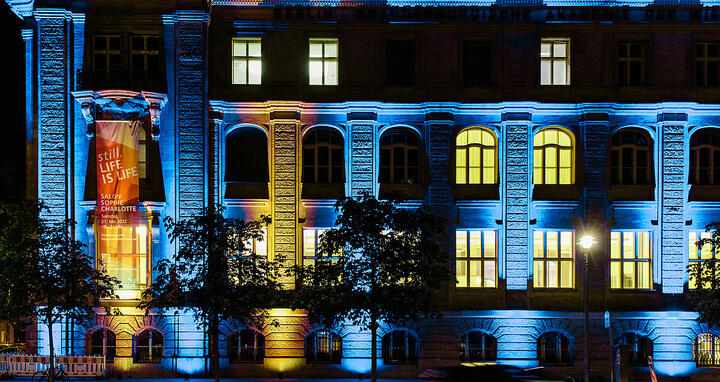Spinning the circle of life
Singers of the choir cantamus.berlin
The rotunda of the Berlin-Brandenburg Academy of Sciences and Humanities (BBAW) at Gendarmenmarkt is filling with sound. Singers from the cantamus.berlin choir have gathered around the circular railing in the stairwell on the third floor, and a piece by the composer Andrea Tarrodi is being performed. On the floors above and below, visitors to the Salon Sophie Charlotte listen to the tunes. As the choir moves away singing, the circle of sound slowly dissolves. Performances like these are the hallmark of the BBAW's annual Salon Sophie Charlotte, which reflects on a particular focus in a variety of ways: primarily from a scientific perspective, but also from an artistic one. A circle of sound, joined together for a few minutes and then disintegrating again, shows the beauty, uniqueness and temporal limitedness of life.
"Forever young - forever healthy?" was the question that visitors circled around that evening in the room of the Salon hosted by the Max Delbrück Center for Molecular Medicine (MDC). Two women presented their work, one an artist, the other a scientist and physician. The Lab of Professor Simone Spuler at the Experimental and Clinical Research Center of Charité and MDC introduces the gene scissors CRISPR into defective muscle cells, which they have previously taken from patients, as messenger RNA. After the gene scissors have repaired the cells, the team plans to re-inject them into the patients in a first clinical trial. There are about 50 severe muscular dystrophies, and so far they cannot be cured. "CRISPR/Cas9 technology offers hope for many patients suffering from these terrible diseases," said Simone Spuler.
The discussion focused primarily on ethics
The scientist and physician emphasized that working with genetic scissors is indeed an attempt to modify the genome. However, careful checks are made to ensure that it does not have any undesirable side effects. The technology offers great opportunities: About 7,000 diseases, the researcher reported, are monogenetic, meaning they can be traced back to a single error in the genetic information. So far, only 500 of them are treatable. CRISPR/Cas9 technology, however, makes it feasible in principle to repair the underlying defects.
In the subsequent discussion, the guests not only asked about how CRISPR/Cas technology works in greater detail. Above all, it was about ethics. One audience member wondered whether genetic diseases such as muscular dystrophies could be detected during pregnancy. Yes, it could be done - but she was strictly against interventions before birth, Simone Spuler emphasized: "That's an area we shouldn't touch." So far, the possibilities of such gene therapies are limited anyway. For example, it is not possible to target and cure all affected cells in the body, nor is it possible to treat diseases that are based on a combination of several genetic defects. "Such diseases will remain a mystery to us for a long time to come," said Simone Spuler.
The tension between what is possible and what is desirable is the focus of Emilia Tikka's work. The Finnish artist was a Artist in Residence at MDC in 2018, focusing on the possibilities of human enhancement - the improvement of the healthy human body - in a critical way. "I wanted to bring out the poetic, the unknown in science," she said at the Salon. Specifically, she was interested in the question of what might actually happen if people were able to use biomedicine to alter the aging process.
The story of a couple
Photo from the artwork ÆON
What if a life-extending technology became a consumer product? Emilia Tikka thought up an inhaler that allows people to inhale substances that keep them young. She thus created the story of a couple, one of whom has chosen physical aging, the other against it. A series of photographs of the juvenile man and the aged woman ran in a continuous loop across a wall in the MDC Salon right behind the inhaler on display. One of the images showed the man tenderly touching the woman's face, wearing plastic gloves and a mask. He remains young, but his body is still exposed to health threats and is not immortal. "The idea of a pandemic threat seemed far-fetched in 2018, and many found this vision overblown at the time. In the meantime, reality has unfortunately caught up with my speculations," Emilia Tikka said. Would she herself use the inhaler if it existed? She does not know, said the artist.
Late that evening, the room begins to empty. Simone Spuler accompanies a group of four men out; they are three young students and an older gentleman. "He used to be an ambassador and is writing a book that deals with gene therapies. The three first-year students are majoring in medicine. All four want to visit me in my lab, and the author wants to work with me for a while. I think that's great," says the MDC researcher. There are enough open questions, as this evening has shown.
Text: Wiebke Peters
Further information
- Profile of Simone Spuler: “A pioneer in muscle repair”
- About the project by Emilia Tikka: "Eternal youth?"










